No Mow May
Posted on Tuesday, April 25, 2023 · Leave a Comment
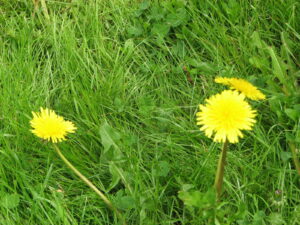
Dandelions in lawn help feed pollinators early in the spring
In 2019 a British non-profit called Plantlife coined the phrase “No Mow May”. They proposed that gardeners leave their mowers in storage for the month of May in order to let wildflowers and weeds bloom and provide pollen and nectar for pollinators. And of course the caterpillars of many pollinators feed all our baby birds, so the ramifications are vast.
Early spring is a tough time for pollinators, especially here in New England as there are not many flowers to visit. I like the idea of a simple action that can have positive effects on so many species of wildlife.
The most obvious advantage to you is that you have a few extra hours to do other things in your garden. May is a busy time for most of us: raking out beds, pulling weeds that wintered over and are starting to grow in our beds. Planting early vegetables and flowers. Shopping for new plants. We can even bask in the sun like seals if we have the time to do so.
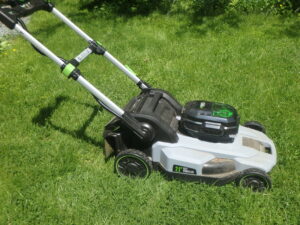
Electric mowers have improved greatly in the past few years. They are quiet and non-polluting
Next, you are not spending any money on gas or electricity (if you have a battery-powered mower). Most gas powered mowers do not have the emission controls that are required for cars. According to the Environmental Protection Agency (EPA), one hour operating a new gasoline lawn mower emits the same amount of volatile organic compounds and nitrogen oxide as driving a new car 45 miles.
According to the EPA, lawn mowers and other garden machines like leaf blowers, string trimmers, etc., contribute as much pollution as our cars and homes. The statistics on lawns are deceiving; two percent of the land mass in America is lawn. But that is more square miles of land than all the corn grown here. Roughly 80% of homes have at least some lawn.
If we mow our lawns from May to the end of October, that’s six months of mowing. Eliminating one month of mowing reduces those emissions by 17%. Good for the environment, good for the wallet.
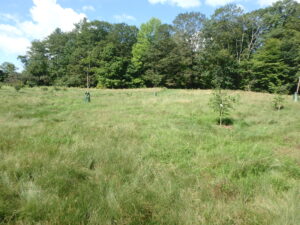
We stopped mowing this lawn and here it is in late August
For the last two years I have been installing trees in what was a 5-acre lawn in Hanover, NH. So far we have planted about 150 of them – and we largely stopped the mowing, just leaving pathways throughout. The owners now have their field mowed everywhere just once every two years to control growth of unwanted woody plants like poplars, which spread by root.
We were delighted last spring to see the field come alive in spring. At least a dozen species of flowers bloomed, probably more. And the bees and other pollinators just loved it.
You must be wondering what happened when we just stopped mowing. Grass grew, and largely flopped over as it got taller. It was nothing like the unruly 2- or 3-foot tall mess that the mowing guys predicted. We were always able to walk anywhere in the field even though it was not mowed. Of course, when the mowing crew shows up soon, they have big, industrial-scale mowers that will chew up anything.
For your home lawn you may want to pay attention to how tall the grass gets in May. Presumably your push mower or electric mower will not mow tall grasses as easily as the riding mowers used on the field described above. If you can only avoid mowing for two or three weeks, it’s still better than mowing it short every week in May.
Another advantage to the No Mow May is that you will probably end up with a better, more resilient lawn in times of drought. The longer your grass, the more food it produces for the roots, allowing them to grow longer and deeper.
Your lawn might complain about being mowed short on June 1. So put the blades up as high as they go, to avoid giving the lawn that “scalped” look. The lower parts of blades of grass may be a little pale in color as they were shaded out by the taller parts. Leave your lawn a little longer this year – it doesn’t have to look like the infield of Fenway Park.
What about bare spots on the lawn? These are often filled in with crabgrass, an annual weed. For large areas, you will need to plant new lawn seed – the sooner the better.
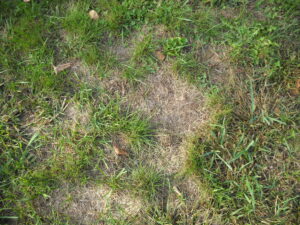
This part of the lawn needs re-seeding
Filling in empty spots can be done in May by scratching the soil with a short-tined rake to loosen the surface. Add half an inch of compost and mix it in with the soil. Then spread seed over it – just broadcast it with your hand in small areas. I use a lawn/leaf rake to mix the seed in with the soil: I flip over the rake and drag it lightly over the area, which mixes in the seed well. If you have a metal tamper, use it to press down the planted area. If not, use a small board and step on it.
I never fertilize my lawn, and it looks fine to me. If your lawn is a little feeble, check the soil pH. If it is too acidic, you can spread some limestone. Lawn grass prefers nearly neutral pH.
So take a break from mowing this May. Tell your neighbors what’s going on, so they won’t call you a lazy slug! You are just being environmentally conscious. Thanks!
Henry is an organic
gardener who has lived in the same house since he bought it in 1970. He is the author of 4
gardening books. Reach him at
henry.homeyer@comcast.net.
Six Wildflowers You Should Grow
Posted on Tuesday, May 5, 2020 · Leave a Comment
I love wildflowers. Right now several species are blooming in my woods, and others are on their way. They are a demure smile before the serious romance of summer blossoms in the main gardens. But after winter, they are loved as much as the bodacious peonies and brilliant poppies that will come later.
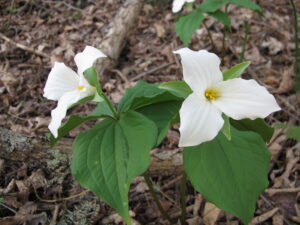
White trillium or Trillium grandiflorum
One of my favorites is Trillium. That is both a scientific name and a common name, though the common wine red species, Trillium erectum, is also called Purple Trillium, Wake-robin and Stinking Benjamin. It does best in light shade and acidic soils. Its flower has three petals and stands up above the foliage. As it matures over the years, the clumps get bigger. A related species, T. grandiflorum, or white trillium is similar in looks, but with white petals that fade to pink. It’s very lovely.
Another favorite of mine is Jack-in-the Pulpit ( Arisaema triphyllum). The flower has a hood over a “preacher” that is hidden inside. It is designed so that little flies will crawl down inside the flower, pollinating it as they go. It has both male and female parts, but only one or the other are fertile at a time, to prevent self-pollination. They grow well in woodlands, in deep rich acid soil. As the plants grow older, they get larger, sometimes reaching two feet tall.
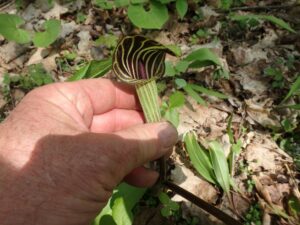
Jack in the pulpit
Hepatica is one of the earliest wildflowers to bloom in my woods. The common name, Hepatica, is also the scientific name, though there are two similar species: H. acutiloba or Sharp-lobed Hepatica, and H. americana or Round-lobed Hepatica.
Hepatica grows in light shade, and does best with a few hours of sunshine. They do best in rich, dark, humusy soil. They form tidy clumps, each about the size of a big African violet. The blossoms are numerous: an old clump in my woods has about 50 one-inch wide lavender flowers on it now, each with six petals. This plant does not spread much, so buy enough to make a statement.
Bloodroot is a beauty that spreads well by root, though is never obnoxious about it. This fabulous wildflower has blossoms similar to those on Hepatica, but bigger, and white with a yellow center. The blossoms are quite ephemeral, blooming and then littering the ground some days later with petals. The flowers close up at night (when pollinators are sleeping) or on cold, rainy days.
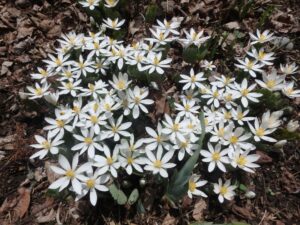
Bloodroot likes good drainage and more sun than most wildflowers
The leaves are dramatic. When they first appear, they are rolled up like a cigar, standing vertically in your forest duff. Later the leaves open and flatten out, getting large for a wildflower: six to eight inches wide. These persist much of the summer, creating a nice groundcover.
Bloodroot gets its name from the red liquid it oozes if you break a root. You can propagate the plant by diving roots when dormant in the fall and planting in light shade or morning sun in moist, well-drained soil.
Another of my favorites is Dutchman’s breeches ( Dicentra cucularia). This is a true spring ephemeral: it produces flowers and leaves, and then everything disappears after a few weeks until next year. It is in the same genus as Bleeding Heart, a dramatic pink or white June-blooming perennial. The flowers are white, and look like little pants hanging upside down, with several flowers on each stem.
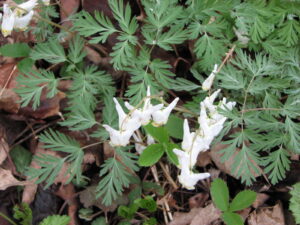
Dutchman’s breeches
The foliage is as pretty as the flowers: it is finely cut, and reminiscent of its cousin, wild bleeding heart ( Dicentra exemia) which is sold everywhere as a shade perennial. When Dutchman’s Breeches dies back, the leaves just disappear without yellowing and lingering on, which is a nice feature. It does best in moist, rich soil in shade or part sun. The corms are tiny.
Finally, you should have some trout lily or Dog-toothed Violet ( Erythronium americanum). This diminutive plant has nice spotted leaves and spreads like a groundcover in shady, humus-rich woods. But in the wild, they bloom infrequently, and only after they have two leaves – and most of mine have just one. The flowers are yellow on 4 inch stems.
So how do you get started? Most garden centers do not sell these plants, and seeds are not readily available – and often need to be planted right after picking. You should not dig them up in the wild and doing so is prohibited in most states.
I called Barry Glick of Sunshine Farm and Gardens in Renick, West Virginia. His farm is 60 acres of flowers at 3,650 feet of elevation, so Zone 5. He agreed to put together a package of the plants I have featured here, three plants of each, ready to go in the ground for $89.10 as a special deal for my readers. They will be shipped free by Priority Mail. E-mail him at
barry@sunfarm.com for details and tell him I sent you.
In interest of full disclosure, Barry sent me a set of plants for free, but I am not profiting from his sales. The plants (or bulbs or corms without leaves) are not huge, but are 3 to 5 years old, and ready to bloom next year. They come in half gallon Ziplock bags, packed in peat moss and ready to plant. All mine looked great, and I planted them in an open woodland with rich soil.
So think about getting some wildflowers, and remember you shouldn’t just go dig them up in the wild! Wildflowers bring me great joy when they bloom, and I bet they will please you, too.










